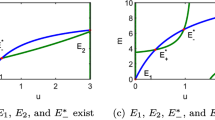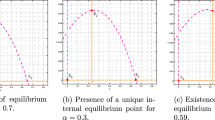Abstract
Keeping in mind the interactions between budmoths and the quality of larch trees located in the Swiss Alps (a mountain range in Switzerland), a discrete-time model is proposed and studied. The novel model is proposed with implementation of a nonlinear functional response that incorporates plant quality. The proposed functional response is validated with real observed data of larch budmoth interactions. Furthermore, we investigate the qualitative behavior of the proposed discrete-time system with interactions between budmoths and the quality of larch trees. Proofs of the boundedness of solutions, and the existence of fixed points and their topological classification are carried out. It is proved that the system experiences period-doubling bifurcation at its positive fixed point using the center manifold theorem and normal forms theory. Moreover, existence and direction for the torus bifurcation are also investigated for larch budmoth interactions. Bifurcating and fluctuating behaviors of the system are controlled through utilization of chaos control strategies. Numerical simulations are presented to demonstrate the theoretical findings. At the end, theoretical investigations are validated with field and experimental data.


















Similar content being viewed by others
Data availability
Data sharing not applicable to this article as no datasets were generated or analysed during the current study.
References
Ginzburg, L.R., Taneyhill, D.E.: Population cycles of forest Lepidoptera: a maternal effect hypothesis. J. Anim. Ecol. 63, 79–92 (1994)
Myers, J.H.: Can a general hypothesis explain population cycles of forest Lepidoptera? Adv. Ecol. Res. 18, 179–242 (1988)
Baltensweiler, W., Rubli, D.: Dispersal: an important driving force of the cyclic population dynamics of the larch bud moth. For. Snow Landsc. Res. 74(1), 3–153 (1999)
Wermelinger, B., Forster, B., Nievergelt, D.: Cycles and importance of the larch budmoth. WSL Fact Sheet 61, 1–12 (2018)
Zimmer, C.: Life after chaos. Science 284, 83–86 (1999)
Esper, J., Buntgen, U., Frank, D.. C., Nievergelt, D., Liebhold, A.: 1200 years of regular outbreaks in alpine insects. Proc. R. Soc. Lond. Ser. B 274, 671–679 (2007)
Konter, O., Esper, J., Liebhold, A., Kyncl, T., Schneider, L., Duthorn, E., Buntgen, U.: Tree-ring evidence for the historical absence of cyclic larch budmoth outbreaks in the Tatra Mountains. Trends. Ecol. Evol. 29, 809–814 (2015)
Baltensweiler, W., Fischlin, A.: The larch budmoth in the Alps. In: Berryman, A. (ed.) Dynamics of Forest Insect Populations: Patterns, Causes, Implications, pp. 331–351. Plenum, New York (1988)
Baltensweiler, W.: Why the larch bud-moth cycle collapsed in the subalpine larch-cembran pine forests in the year 1990 for the first time since 1850. Oecologia 94, 62–66 (1993)
Berryman, A.A.: What causes population cycles of forest Lepidoptera? Trends. Ecol. Evol. 11, 28–32 (1996)
Battipaglia, G., et al.: Long-term effects of climate and land-use change on larch budmoth outbreaks in the French Alps. Clim. Res. 62, 1–14 (2014)
Turchin, P.: Complex Population Dynamics. Princeton University Press, New Jersey (2003)
Jang, S.R.-J., Johnson, D.M.: Dynamics of discrete-time larch budmoth population models. J. Biol. Dyn. 3, 209–223 (2009)
Jang, S.R.-J., Yu, J.-L.: Models of plant quality and larch budmoth interaction. Nonlinear Anal. Theory Methods Appl. 71(12), e1904–e1908 (2009)
De Silva, T.M.M., Jang, S.R.-J.: Period-doubling and Neimark–Sacker bifurcations in a larch budmoth population model. J. Differ. Equ. Appl. 23(10), 1619–1639 (2017)
Iyengar, S.V., Balakrishnan, J., Kurths, J.: Impact of climate change on larch budmoth cyclic outbreaks. Sci. Rep. 6, 27845 (2016)
Balakrishnan, J., Iyengar, S.V., Kurths, J.: Missing cycles: effect of climate change on population dynamics. Indian Acad. Sci. Conf. Ser. 1(1), 93–99 (2017)
Ali, I., Saeed, U., Din, Q.: Bifurcation analysis and chaos control in a discrete-time plant quality and larch budmoth interaction model with Ricker equation. Math. Methods Appl. Sci. 42(18), 7395–7410 (2019)
Yang, X.: Uniform persistence and periodic solutions for a discrete predatorprey system with delays. J. Math. Anal. Appl. 316, 161–177 (2006)
Carr, J.: Application of Center Manifold Theory. Springer, New York (1981)
Guzowska, M., Luís, R., Elaydi, S.: Bifurcation and invariant manifolds of the logistic competition model. J. Differ. Equ. Appl. 17(12), 1851–1872 (2011)
Luís, R., Elaydi, S., Oliveira, H.: Stability of a Ricker-type competition model and the competitive exclusion principle. J. Biol. Dyn. 5(6), 636–660 (2011)
Karydas, N., Schinas, J.: The center manifold theorem for a discrete system. Appl. Anal. 44(3–4), 267–284 (1992)
Kulenović, M.R.S., Merino, O.: Invariant manifolds for competitive discrete systems in the plane. Int. J. Bifurc. Chaos 20(8), 2471–2486 (2010)
Psarros, N., Papaschinopoulos, G., Schinas, C.J.: Semistability of two systems of difference equations using centre manifold theory. Math. Methods Appl. Sci. 39(18), 5216–5222 (2016)
Guckenheimer, J., Holmes, P.: Nonlinear Oscillations, Dynamical Systems, and Bifurcations of Vector Fields. Springer, New York (1983)
Robinson, C.: Dynamical Systems: Stability. Symbolic Dynamics and Chaos, Boca Raton, New York (1999)
Wiggins, S.: Introduction to Applied Nonlinear Dynamical Systems and Chaos. Springer, New York (2003)
Wan, Y.H.: Computation of the stability condition for the Hopf bifurcation of diffeomorphism on \(R^2\). SIAM. J. Appl. Math. 34, 167–175 (1978)
Kuznetsov, Y.A.: Elements of Applied Bifurcation Theory. Springer, New York (1997)
Din, Q.: Stability, bifurcation analysis and chaos control for a predator-prey system. J. Vib. Control 25(3), 612–626 (2019)
Din, Q., Shabbir, M.S., Khan, M.A., Ahmad, K.: Bifurcation analysis and chaos control for a plant-herbivore model with weak predator functional response. J. Biol. Dyn. 13(1), 481–501 (2019)
Abbasi, M.. A., Din, Q.: Under the influence of crowding effects: stability, bifurcation and chaos control for a discrete-time predator–prey model. Int. J. Biomath. 12(04), 1950044 (2019)
Din, Q., Hussain, M.: Controlling chaos and Neimark–Sacker bifurcation in a host-parasitoid model. Asian J. Control 21(3), 1202–1215 (2019)
Din, Q., Iqbal, M.A.: Bifurcation analysis and chaos control for a discrete-time enzyme model. Z. Naturforsch. A 74(1), 1–14 (2019)
Ishaque, W., Din, Q., Taj, M., Iqbal, M.A.: Bifurcation and chaos control in a discrete-time predator-prey model with nonlinear saturated incidence rate and parasite interaction. Adv. Differ. Equ. 2019, 28 (2019)
Elsayed, E.M., Din, Q.: Period-doubling and Neimark–Sacker bifurcations of plant-herbivore models. Adv. Differ. Equ. 2019, 271 (2019)
Din, Q.: A novel chaos control strategy for discrete-time Brusselator models. J. Math. Chem. 56(10), 3045–3075 (2018)
Din, Q.: Bifurcation analysis and chaos control in discrete-time glycolysis models. J. Math. Chem. 56(3), 904–931 (2018)
Din, Q., Donchev, T., Kolev, D.: Stability, bifurcation analysis and chaos control in chlorine dioxide-iodine-malonic acid reaction. MATCH Commun. Math. Comput. Chem. 79(3), 577–606 (2018)
Din, Q., Saeed, U.: Bifurcation analysis and chaos control in a host-parasitoid model. Math. Method Appl. Sci. 40(14), 5391–5406 (2017)
Din, Q.: Qualitative analysis and chaos control in a density-dependent host-parasitoid system. Int. J. Dyn. Control 6(2), 778–798 (2018)
Din, Q.: Neimark–Sacker bifurcation and chaos control in Hassell–Varley model. J. Differ. Equ. Appl. 23(4), 741–762 (2017)
Din, Q., Haider, K.: Discretization, bifurcation analysis and chaos control for Schnakenberg model. J. Math. Chem. 58(8), 1615–1649 (2020)
Din, Q., Saleem, N., Shabbir, M.S.: A class of discrete predator–prey interaction with bifurcation analysis and chaos control. Math. Model. Nat. Phenom. 15, 60 (2020)
Ott, E., Grebogi, C., Yorke, J.A.: Controlling chaos. Phys. Rev. Lett. 64(11), 1196–1199 (1990)
Luo, X.S., Chen, G.R., Wang, B.H., Fang, J.Q.: Hybrid control of period-doubling bifurcation and chaos in discrete nonlinear dynamical systems. Chaos Soliton Fract. 18(4), 775–783 (2003)
Baltensweiler, W., Weber, U.M., Cherubini, P.: Tracing the influence of larch-bud-moth insect outbreaks and weather conditions on larch tree-ring growth in Engadine (Switzerland). Oikos 117, 161–172 (2008)
Acknowledgements
The authors thank the main editor and anonymous referees for their valuable comments and suggestions leading to improvement of this paper.
Author information
Authors and Affiliations
Corresponding author
Ethics declarations
Conflict of interest
The authors declare that they have no known competing financial interests or personal relationships that could have appeared to influence the work reported in this paper.
Additional information
Publisher's Note
Springer Nature remains neutral with regard to jurisdictional claims in published maps and institutional affiliations.
Appendix A: Calculation Related to PDB
Appendix A: Calculation Related to PDB
and
Rights and permissions
About this article
Cite this article
Din, Q., Khan, M.I. A Discrete-Time Model for Consumer–Resource Interaction with Stability, Bifurcation and Chaos Control. Qual. Theory Dyn. Syst. 20, 56 (2021). https://doi.org/10.1007/s12346-021-00488-4
Received:
Accepted:
Published:
DOI: https://doi.org/10.1007/s12346-021-00488-4
Keywords
- Larch budmoth interaction
- Stability
- Period-doubling bifurcation
- Neimark–Sacker bifurcation
- Chaos control




